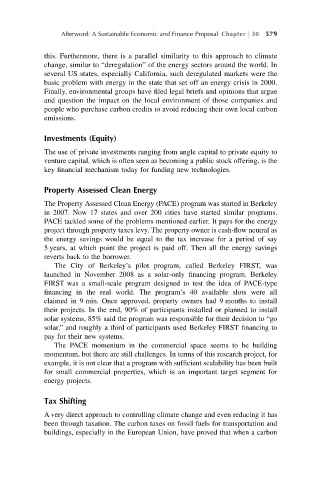Page 612 - Sustainable Cities and Communities Design Handbook
P. 612
Afterword: A Sustainable Economic and Finance Proposal Chapter j 30 579
this. Furthermore, there is a parallel similarity to this approach to climate
change, similar to “deregulation” of the energy sectors around the world. In
several US states, especially California, such deregulated markets were the
basic problem with energy in the state that set off an energy crisis in 2000.
Finally, environmental groups have filed legal briefs and opinions that argue
and question the impact on the local environment of those companies and
people who purchase carbon credits to avoid reducing their own local carbon
emissions.
Investments (Equity)
The use of private investments ranging from angle capital to private equity to
venture capital, which is often seen as becoming a public stock offering, is the
key financial mechanism today for funding new technologies.
Property Assessed Clean Energy
The Property Assessed Clean Energy (PACE) program was started in Berkeley
in 2007. Now 17 states and over 200 cities have started similar programs.
PACE tackled some of the problems mentioned earlier. It pays for the energy
project through property taxes levy. The property owner is cash-flow neutral as
the energy savings would be equal to the tax increase for a period of say
5 years, at which point the project is paid off. Then all the energy savings
reverts back to the borrower.
The City of Berkeley’s pilot program, called Berkeley FIRST, was
launched in November 2008 as a solar-only financing program. Berkeley
FIRST was a small-scale program designed to test the idea of PACE-type
financing in the real world. The program’s 40 available slots were all
claimed in 9 min. Once approved, property owners had 9 months to install
their projects. In the end, 90% of participants installed or planned to install
solar systems, 85% said the program was responsible for their decision to “go
solar,” and roughly a third of participants used Berkeley FIRST financing to
pay for their new systems.
The PACE momentum in the commercial space seems to be building
momentum, but there are still challenges. In terms of this research project, for
example, it is not clear that a program with sufficient scalability has been built
for small commercial properties, which is an important target segment for
energy projects.
Tax Shifting
A very direct approach to controlling climate change and even reducing it has
been through taxation. The carbon taxes on fossil fuels for transportation and
buildings, especially in the European Union, have proved that when a carbon

